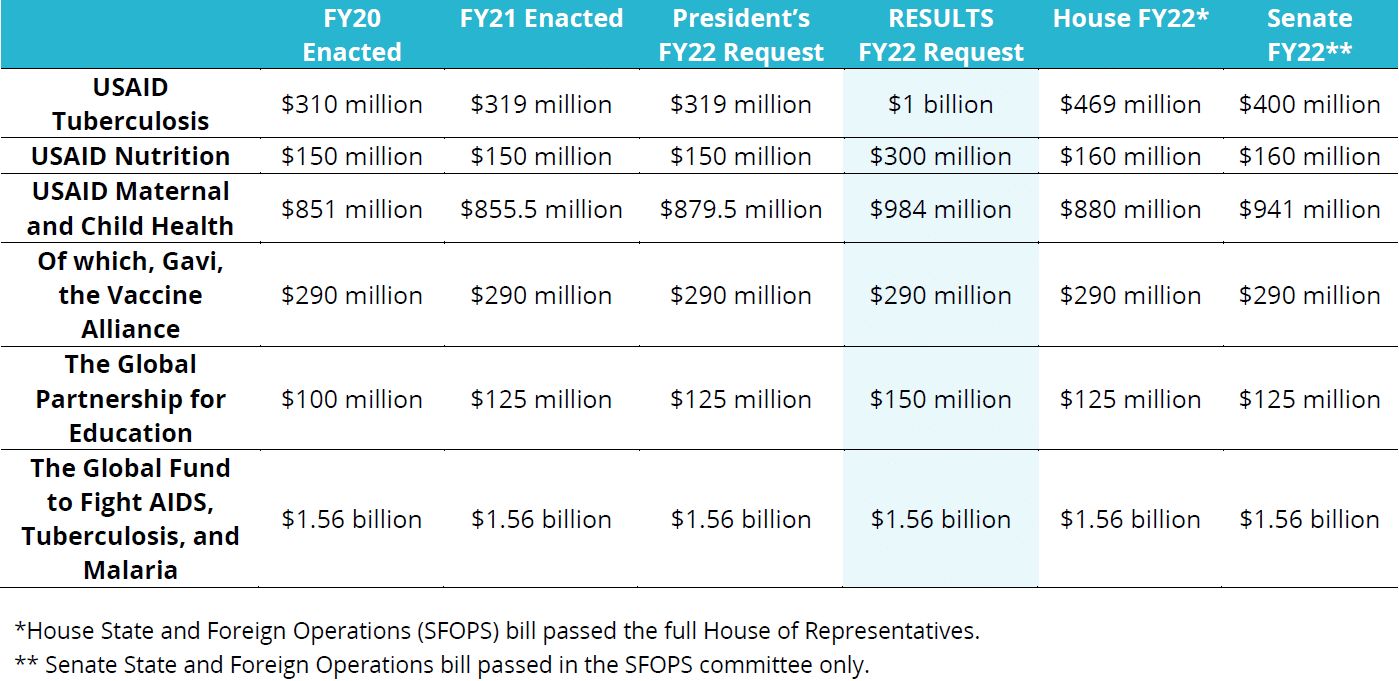Mixed Bag in FY22 Senate Foreign Aid Spending Bill
After the Senate failed to pass 9 of the 12 appropriations bills through sub-committee and regular order, Chairman Patrick Leahy, Chair of the Senate Appropriations Committee, released the full text of the remaining spending bills on Monday afternoon. This included the State and Foreign Operations (SFOPS) bill, which includes several accounts RESULTS has been advocating for since February. Although there was some good news in the Senate appropriations bills overall—including a proposed 13 percent increase in non-defense programs—the SFOPS bill was a mixed bag.
Most notably in the SFOPS bill Senate appropriators included a $60 million increase to the USAID Maternal and Child Health program (significantly higher than the President’s Budget Request which proposed cutting funding). The bill also includes a significant increase in tuberculosis funding but falls $69 million short of what the House proposed. Several other accounts received modest top ups or funding was maintained (see chart below). However, given the increased cost of providing services during COVID-19 plus inflation, maintaining funding is equivalent to a cut in funding.
What’s next?
Because both chambers of Congress did not agree on topline funding levels, the SFOPS bill (and other appropriations bills) will head to a conference committee. A conference committee is a joint committee of Congress appointed by the House of Representatives and Senate to resolve disagreements on a particular bill.
What’s at stake?
If the House and Senate fail to reach an agreement on the appropriations bills (including the SFOPS bill) by December 3, it could result in a one-year stopgap measure called a “continuing resolution (CR).” A CR funds the government according to levels from the year before, with little room to increase budgets.
The last annual appropriations bill was passed in December 2020 and did not address COVID-19 as supplemental funding for COVID relief was still under negotiation. This legislation will be the first annual appropriations bill that starts to address the new COVID-19 reality with variants growing, and immunization rates in richer countries severely outpacing most low-income countries. Even still, the deadly Delta variant of COVID-19 continues to devastate communities and make delivering essential healthcare services even more difficult and expensive.
While this bill does include increased resources around “global health security” to prevent emerging threats, low income-countries need more resources to scale up their current delivery of COVID-19 vaccines and treatment, as well as “catch-up” programs to maintain existing health and education programs.
For example, due to COVID-19 mitigation measures like physical distancing and movement restrictions, many low-income countries cancelled mass vaccination campaigns. This led to an estimated 100 million children missing their first round of vitamin A supplementation in 2020. This may not seem like a big deal—but missing doses increases the risk of child mortality and threatens to undo years of work by countries to implement effective vitamin A supplementation programs.
Meanwhile, the Global Fund to Fight AIDS, Tuberculosis, and Malaria reported the number of people tested and treated for TB dropped by nearly 20 percent in 2020 compared to 2019. This could lead to hundreds of thousands of more unnecessary deaths from an entirely preventable and treatable disease.
Take action now.
We cannot afford to solve today’s problems with 2020’s budget. In order to stop the spread of COVID-19, mitigate shocks to essential services and regain lost ground in the fight against infectious diseases, maternal and child mortality, and the disruption of schooling for young children – Congress must act now.
We have been working hard on our appropriations advocacy for months—now it’s time to get it across the finish line. Contact your member of Congress today and request they finalize the FY22 bills and refuse a full year continuing resolution. Urge them to support the highest level of proposed funding for these lifesaving and life-sustaining programs in any final bill.
